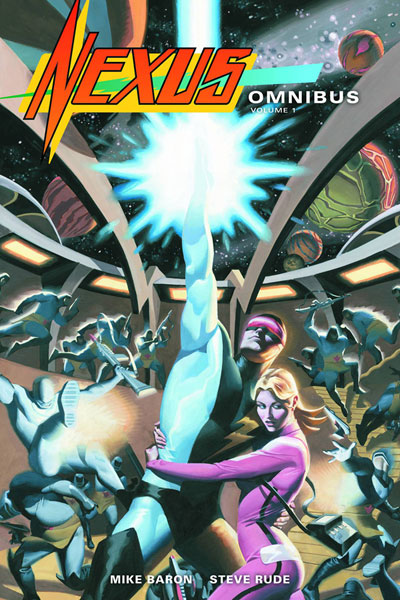For Your Consideration: Dark Horse’s Nexus Omnibus Vol. 1
by Robert Greenberger
So there I was, in 1981 minding my own business, readying to launch Comics Scene and I get a package of material from some guy named Richard Bruning, editor of the newly formed Capital Comics imprint of the Capital Comics distribution firm. Within the package was the first issue of their black and white magazine called Nexus. It was written and drawn by guys I never heard of but figured if a major distributor was behind these guys it was worth a read.
I was hooked. So much so, I wrote an effusive letter which was excerpted in some of the advertising (always an ego boost) and championed the project even after Capital folded and the series was taken over by First Comics. In short order, Mike Baron and Steve Rude represented two of the freshest voices in comics. If anything, these two epitomized the potential of the Direct Sales market, which by then was just becoming an opportunity for new companies to offer different kinds of comics.
And Nexus was different. First of all, it was science fiction and secondly, the hero was an executioner, plying the byways of interstellar space, dispatching those judged guilty. In time, we learned how he got his amazing powers, from an entity known as The Merk, and got to meet a colorful assortment of supporting characters. The character drifted from company to company, always finding a welcome home until there were actually over 100 issues.
Thankfully, Dark Horse has collected the first 80 of those in a series of Archives but now comes the first Nexus Omnibus, collecting Nexus Volume 1 #1-3 (the Black and White mag), Nexus volume 2 #1-11 (the first six from Capital, the final five from First). The timing couldn’t be better considering the character made his first new appearance in ages in Dark Horse Presents #12.
This 416 page extravaganza is worth a look in case you’re unfamiliar with the character and you will easily see why it earned six Eisner Awards, including Best Artist/Penciller/Inker or Penciller/Inker Team in 1988; Best Single Issue/Single Story and Best Writer/Artist, Best Artist/Penciller/Inker or Penciller/Inker Team (Nexus: Origin, 1993; Best Artist/Penciller/Inker or Penciller/Inker Team in 1988; Best Artist/Penciller/Inker or Penciller/Inker Team (Nexus: Executioner’s Song, 1997), and Best Letterer/Lettering by Todd Klein in 2008.
Horatio Hellpop, Nexus, didn’t ask for these powers but was granted them and needs to execute people in order to retain them so he is the law. “The most intriguing factor of Nexus as a superhero was that every time he appeared somebody had to die. That was his job,” Baron recently told Comic Book Resources. Hellpop would receive his orders through excruciatingly painful dreams and then be forced to hunt down his prey before the pain would fully subside.
“The world and characters are diverse and complex so that we never run out of ideas. Nexus veers from slapstick to drama, to comedy of manners, to tragedy and back again. Ylum continues to evolve as more and different visitors pour in. As for Hellpop himself, we try to keep him interesting. He tells me what he wants. He’s a complex man.”
It’s that complexity of character and expansive storytelling that keeps things interesting and surprising. Since its inception, the series has addressed politics, government, and war, often inspired by current events. Hellpop is not always happy doing his duty or dealing with some of the more irritating races he encounters. “We will strive to be entertaining without hitting the reader over the head with a political message,” Baron added.
On an individual level, he is frequently accompanied by the alluring Sundra Peale, initially a spy from Mars and eventually his lover. “Baron’s always been open for the free contribution of plot ideas, which is something I’m happy and eager to take him up on,” Rude told CBR. “One of my recent ideas came from reading the tragic story of Vivien Leigh and imagining how it might apply to our female lead, Sundra Peale.”
The series made its mark because both the writer and the artist were new and each had a distinctive style, making them a dynamic pairing that caused readers to open their eyes. While many of the independent companies of the time were producing creator owned works, they tended to be from established talents (Jack Kirby’s Captain Victory, Mike Grell’s Starslayer) but this was all new. The Dude’s animation-inspired style was clean and open for the recently-improved comics coloring while Baron’s snappy dialogue and intricate plotting kept you coming back for more.
Purchase

USER COMMENTS
We'd love to hear from you, feel free to add to the discussion!